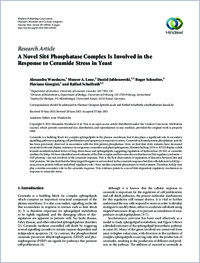A novel sit4 phosphatase complex is involved in the response to ceramide stress in yeast
- Woodacre, Alexandra Department of Genetics, University of Leicester, Leicester, UK
- Lone, Museer A. Division of Biochemistry, Department of Biology, University of Fribourg, Switzerland
- Jablonowski, Daniel Department of Genetics, University of Leicester, Leicester, UK - Institut für Biologie, FG Mikrobiologie, Universität Kassel, Germany
- Schneiter, Roger Division of Biochemistry, Department of Biology, University of Fribourg, Switzerland
- Giorgini, Flaviano Department of Genetics, University of Leicester, Leicester, UK
- Schaffrath, Raffael Department of Genetics, University of Leicester, Leicester, UK - Institut für Biologie, FG Mikrobiologie, Universität Kassel, Germany
-
04.09.2013
Published in:
- Oxidative Medicine and Cellular Longevity. - 2013, vol. 2013, p. 129645
English
Ceramide is a building block for complex sphingolipids in the plasma membrane, but it also plays a significant role in secondary signalling pathways regulating cell proliferation and apoptosis in response to stress. Ceramide activated protein phosphatase activity has been previously observed in association with the Sit4 protein phosphatase. Here we find that sit4Δ mutants have decreased ceramide levels and display resistance to exogenous ceramides and phytosphingosine. Mutants lacking SIT4 or KTI12 display a shift towards nonhydroxylated forms of long chain bases and sphingolipids, suggesting regulation of hydroxylase (SUR2) or ceramide synthase by Sit4p. We have identified novel subunits of the Sit4 complex and have also shown that known Sit4 regulatory subunits—SAP proteins—are not involved in the ceramide response. This is the first observation of separation of function between Sit4 and SAP proteins. We also find that the Sit4p target Elongator is not involved in the ceramide response but that cells deficient in Kti12p—an accessory protein with an undefined regulatory role—have similar ceramide phenotypes to sit4Δ mutants. Therefore, Kti12p may play a similar secondary role in the ceramide response. This evidence points to a novel Sit4-dependent regulatory mechanism in response to ceramide stress.
- Faculty
- Faculté des sciences et de médecine
- Department
- Département de Biologie
- Language
-
- English
- Classification
- Biological sciences
- License
-
License undefined
- Identifiers
-
- RERO DOC 205472
- DOI 10.1155/2013/129645
- Persistent URL
- https://folia.unifr.ch/unifr/documents/303272
Statistics
Document views: 110
File downloads:
- pdf: 144
